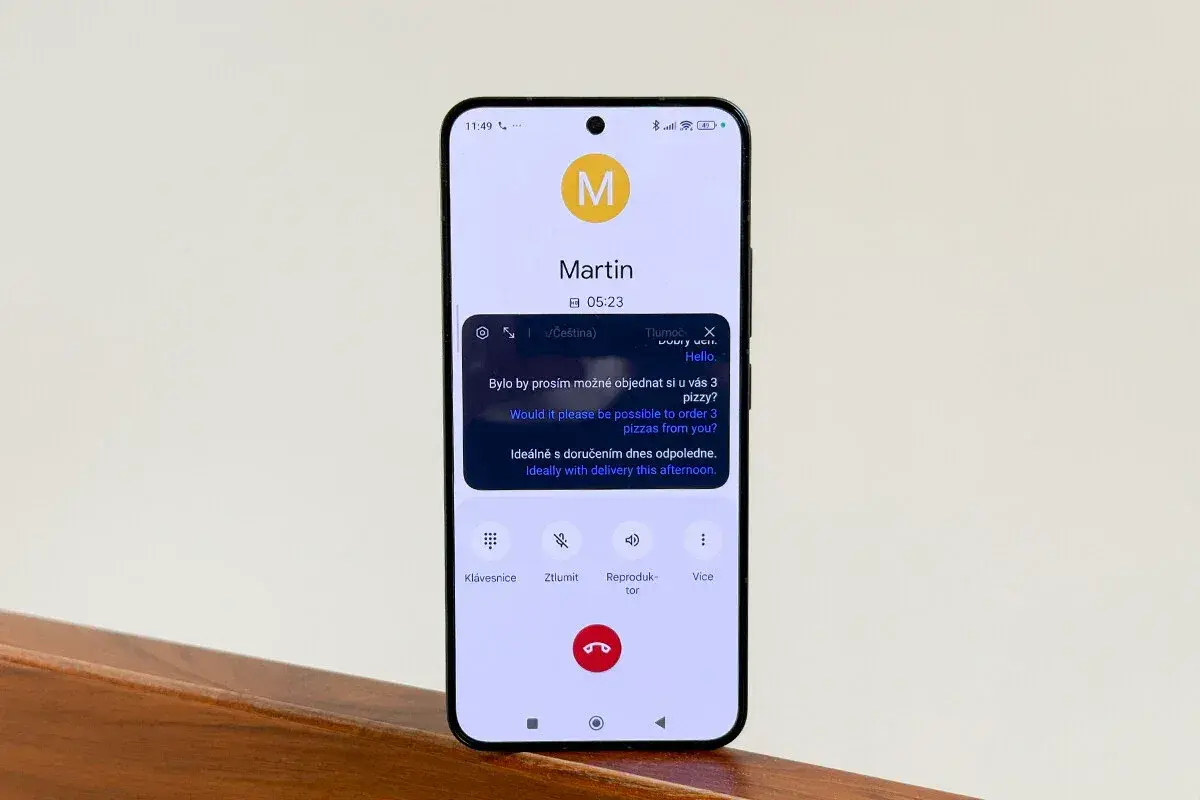
AI Interpreter in Xiaomi Smartphones for Real-Time Calls
Bubbles
April 14, 2025
Xiaomi’s AI Interpreter: Your Comprehensive Guide to Seamless Real-Time Translation
In today’s globalized world, language barriers can be a significant hindrance to effective communication, whether you’re traveling, conducting business, or simply chatting with friends abroad. Xiaomi smartphones—including the popular Redmi line—are now equipped with a groundbreaking feature known as the AI Interpreter. This innovative function is designed to facilitate real-time translation during phone calls, essentially acting as a pocket translator to bridge communication gaps between speakers of different languages. In this article, we take an in-depth look at the Xiaomi AI Interpreter, outlining its features, how to enable it, and its practical applications without any spoilers or unnecessary technical jargon.
Understanding the AI Interpreter
At its core, the Xiaomi AI Interpreter is a built-in translation tool that leverages artificial intelligence to translate spoken language in real time during phone calls. The feature is designed to work seamlessly with Xiaomi’s proprietary software ecosystem, meaning that users don’t need to download any additional apps to enjoy its benefits. Instead, the AI Interpreter is integrated directly into the phone’s operating system, ensuring that it is readily available when needed.
This tool is especially useful for individuals who often find themselves in situations where language differences might hinder clear communication. Whether you are negotiating with an accommodation provider overseas, interacting with local authorities, or simply catching up with a friend who speaks another language, the AI Interpreter offers a quick and reliable solution.
How to Enable the AI Interpreter
Although the Xiaomi AI Interpreter is pre-installed on compatible devices, manual activation is recommended to ensure it is fully operational when you need it most. Activating the feature involves navigating through several settings on your device. Here’s a step-by-step guide to get you started:
- Accessing Your Settings:
Open the Settings app on your Xiaomi or Redmi smartphone. In today’s Android systems, new features are frequently promoted via prompts. However, it’s best to manually verify that the AI Interpreter is enabled to avoid any last-minute surprises. - Navigating to System Applications:
Use the search function within Settings to look for “View via Other Applications.” Tap on this option and then select “More” or “App Permissions.” From here, find and tap on “View System Applications” to see a list of all the pre-installed system apps. - Activating Mi Ditto:
In the list, locate “Mi Ditto.” This is the application that manages the AI Interpreter’s functionalities. Once you have found it, tap on it and enable the setting labeled “View through other applications.” This step is crucial as it allows Mi Ditto to operate effectively within your device’s ecosystem. - Granting Permissions to Xiaomi Hyperai:
Similarly, you will need to ensure that the “Xiaomi Hyperai” technology application has the necessary permissions to run. This app supports the AI Interpreter by handling the heavy lifting of translation processes. Make sure you grant all required permissions so that the AI Interpreter can function seamlessly during calls.
Real-Time Translation and Subtitles
One of the standout features of the Xiaomi AI Interpreter is its ability to provide simultaneous voice translation during phone calls. Once activated, the feature translates spoken sentences into your selected language in near real time. Typically, there is a slight delay—usually around 1-2 seconds—but this does not significantly detract from the overall experience. The translations are clear and accurate, ensuring that the core message is effectively conveyed.
In addition to voice translation, the AI Interpreter also offers AI-generated subtitles during calls. These real-time subtitles appear on your screen alongside the voice translation, serving as a handy verification tool. This dual approach not only bolsters understanding but also instills confidence in the accuracy of the translations. For users who may have hearing difficulties or prefer visual cues, this feature is particularly beneficial.
Supported Languages
The versatility of the AI Interpreter is further enhanced by its broad language support. Xiaomi has designed the feature to accommodate a wide range of languages, making it an invaluable tool for international communication. Some of the supported languages include, but are not limited to:
- Azerbaijani
- Malaysian
- Czech
- German
- English
- Spanish
- French
- Indonesian
- Italian
- Dutch
- Uzbek
- Polish
- Portuguese
- Romanian
- Slovak
- Vietnamese
- Turkish
- Greek
- Thai
- Burmese
- Korean
- Japanese
- Chinese (Mandarin)
- Chinese (Cantonese)
- Filipino
This extensive list means that no matter where you travel or with whom you communicate, the AI Interpreter is likely to support your language needs, bridging the gap between different cultures and facilitating smoother conversations.
User Experience and Accuracy
In practical tests, the Xiaomi AI Interpreter has received high marks from users for its impressive translation accuracy. For instance, when tested with Spanish and French speakers, the tool demonstrated approximately 95% accuracy, allowing most conversations to be understood without significant confusion. The slight delay in translation—typically 1-2 seconds—is often compared to the natural lag in radio communications, but it does not detract from the overall efficiency of the system.
Users have praised the feature for its ability to handle complex sentences and varied vocabulary without compromising on the quality of translation. The system’s effectiveness in managing nuanced dialogue means that it can be used in both casual conversations and more formal interactions without causing misinterpretations. However, like any automated translation tool, it may occasionally struggle with numerals or highly technical language. In such cases, users are advised to rephrase their sentences for clarity.
Practical Applications of the AI Interpreter
The Xiaomi AI Interpreter is not just a novelty; it has a wide range of practical applications that can significantly enhance everyday communication. For travelers, this feature is a game-changer. Imagine arriving in a foreign country and being able to converse effortlessly with hotel staff, local authorities, or even medical professionals during emergencies—all without the need for a dedicated translator. The AI Interpreter makes this possible by providing real-time translation on your phone, ensuring that language barriers do not hinder your experience.
Moreover, the feature can prove invaluable in professional settings. For business travelers who frequently engage with international clients or partners, the AI Interpreter offers a seamless method of communication, helping to bridge cultural divides and facilitate smoother negotiations. The technology also holds promise for educational environments, where language learners can benefit from immediate translations during discussions or lectures.
Frequently Asked Questions About the AI Interpreter
Many users have questions about how the AI Interpreter works and how to get the most out of it. One common query is about the necessity of manually activating the feature. Although some Android systems may prompt you to enable new features automatically, it is advisable to manually check the settings to ensure that the AI Interpreter is fully operational when needed.
Another frequently asked question revolves around the accuracy and potential delay of the translations. Users report that while there is a slight delay of 1-2 seconds, the translations are generally very accurate—around 95% accuracy in most cases. This delay is considered a minor inconvenience compared to the overall benefit of real-time communication.
A further point of interest is the range of supported languages. With support for over twenty languages, including major global tongues like English, Spanish, French, and Mandarin, the AI Interpreter is well-equipped to handle most international communication scenarios. However, users should be aware that the translation might occasionally falter with technical jargon or numerical data, in which case rephrasing can often resolve the issue.
How to Initiate a Translated Call
Using the AI Interpreter during a phone call is straightforward. Once the feature is activated, simply dial the desired number. During the call, you will find an “Interpreting” option available on the side menu of your phone’s interface. Selecting this option will trigger the AI Interpreter to begin translating the conversation in real time. The system will also announce to the other party, via a synthesized voice, that the call is being translated. This announcement is important, as it ensures that all participants are aware of the translation process and can adjust their communication accordingly.
Considerations and Limitations
While the AI Interpreter is a powerful tool, there are a few limitations to be aware of. First, because the feature relies on continuous network connectivity, any interruption in service may affect its performance. Users should ensure they have a stable internet connection for the best experience. Additionally, while the AI Interpreter is excellent for real-time conversations, it is primarily designed for phone calls and may not function with third-party communication apps at this time.
Another consideration is that standard call charges still apply when using the AI Interpreter, unless you have an unlimited calling plan. Therefore, while the feature offers significant advantages in terms of communication, it does not come with any cost-saving benefits related to call rates.
Final Thoughts
Navigating language barriers has never been easier, thanks to Xiaomi’s innovative AI Interpreter. By integrating this advanced translation technology directly into their smartphones, Xiaomi has provided users with a powerful tool that enhances both personal and professional communication. Whether you are traveling abroad, engaging in international business, or simply connecting with friends who speak a different language, the AI Interpreter can help ensure that your message is conveyed accurately and efficiently.
The combination of real-time voice translation and AI-generated subtitles means that users have multiple ways to verify the accuracy of the conversation, making it a robust solution for overcoming language obstacles. As with any emerging technology, there are minor limitations—such as a slight delay in translation and occasional struggles with numerical data—but these are far outweighed by the benefits.
In a world that is increasingly interconnected, the ability to communicate effortlessly across language barriers is more important than ever. Xiaomi’s AI Interpreter is a testament to how technology can simplify our lives, breaking down the walls of language and allowing us to connect with people around the globe in real time.
For those looking to experience this feature firsthand, be sure to check your device’s settings and enable the AI Interpreter following the steps outlined above. And as Xiaomi continues to refine and improve this technology, the future of cross-language communication looks brighter than ever.
Comments
You need to be logged in to comment
No comments yet. Be the first to comment!
Need a website?
Then contact us for professional web development services.
Table of Contents
Share this article
More from the blog

Microsoft’s August 2025 Windows Update Is Breaking Streaming and Raising SSD Fears
Meta Description: Microsoft’s August 2025 Windows update (KB5063878 / KB5063709) is causing major problems for streamers and sparking SSD concerns. Here’s what went wrong, Microsoft’s slow response, an...

Microsoft Zero-Day Bug Exploit: How It Happened and What You Need to Do
Imagine waking up to the news that hackers have a secret key to your company’s data. That’s exactly what happened in July 2025 when a zero-day bug in Microsoft SharePoint was discovered to be under act...

Dembele, Yamal or Salah? Breaking Down the Bookies’ Picks for Ballon d’Or 2025
The Ballon d’Or trophy stands as the pinnacle of individual achievement in football – the gleaming prize that will be awarded on September 22, 2025. After a season of drama (Paris Saint-Germain clinch...